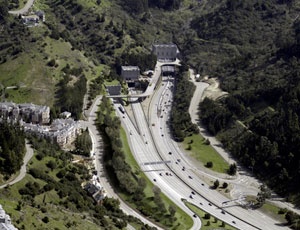The Great Recession has enabled the California Department of Transportation to save approximately $2.4 billion in construction costs for major projects since 2006 due to competition and some bids coming in up to 40% less than estimates, says Kris Kuhl, supervising transportation engineer and official chief for contract awards and services at Caltrans. Overall, Kuhl says that so far this fiscal year, project bids are averaging 33.8% under estimates.


The savings, obviously, means that Caltrans can push for more transportation construction starts, Kuhl adds. �Depending on the nature of the work, we also are seeing a record number of bidders,� he says. �The large projects will have a smaller bidding pool, but some of the other smaller, repair and maintenance projects can get as many as 30 bidders.�
For example, the $1-billion Doyle Drive project in San Francisco is seeing bids coming in 40% less (for contract 3, recently won by C.C. Myers from a pool of eight bidders) and 41% (for contract 4, won by R&L Brosamer also with a pool of eight bidders), Kuhl says.
Construction to replace the 73-year-old seismically vulnerable and visually unattractive Doyle Drive along Presidio Parkway began last year. Funding was enhanced with an infusion of economic stimulus funds from the federal American Recovery and Reinvestment Act.
The Presidio Parkway is to be constructed using eight separate and phased contracts as part of a strategy to both speed construction and provide more contracting and subcontracting opportunities to small and disadvantaged businesses.
Highlights of the new design include:
� A parkway with two short tunnels, a wide landscaped median, traffic-calming transition to city streets and reduced lane and shoulder width.
� A spectacular regional gateway that respects the natural contours of the surrounding area and complements the unique environment of San Francisco and the Presidio, a national park.
� New direct access to the Presidio and enhanced views.
� A more centralized location for transit connections.
The other major San Francisco Bay Area transportation project, the fourth bore for the Caldecott Tunnel in the east bay, was a cost and time bid with the boring phase estimated at $215 million. Winning bidder Tudor Saliba came in 20% under and bid 1,105 days, which was 21% under estimate.
Caltrans and general contractor Tutor-Saliba Corp. broke ground on the Caldecott Tunnel Fourth Bore Project in March, a four-year, $420 million project that will provide numerous jobs for Californians. This is the largest ARRA allocation to date in the nation.
The project is a partnership between Caltrans, the Contra Costa Transportation Authority and the Alameda County Congestion Management Agency. Funded with $197.5 million in federal Recovery Act dollars, $11 million in Proposition 1B monies, as well as other federal, state, regional and local funds, this project will reduce congestion on State Route 24 by building a fourth tunnel bore as part of the Caldecott Tunnel, linking Orinda to Oakland. Upon completion, the new northern bore and the existing northern bore will carry westbound traffic, while the two southern bores will carry eastbound traffic.
The new tunnel will be located to the north of the existing tunnels and have two 12-ft lanes, a 10-ft north shoulder, a 2-ft south shoulder, a 2-ft north emergency walkway and a 3-ft south emergency walkway. The new tunnel will be approximately 41 ft wide and 3,389 ft in length.
Kuhl says two other less expensive Bay Area bridge seismic retrofit projects are getting ready to break ground. The first, the Antioch Bridge, was estimated at $35 million and 300 days; the winning bid, from California Engineering Contractors, came in 65% under. The other, the Dumbarton Bridge, is estimated at $73 million and bids will be advertised on May 25.
With the economy slowly recovering, Kuhl says he expects the bidding environment to return to normal soon, but can�t say exactly when.
�There are now signs that the bids are getting closer to estimates,� he says. �And although there may be fewer bidders during the very busy spring season, the fact is we have a lot of work out there already, which is good for employment.�

Post a comment to this article
Report Abusive Comment